13 Most Sustainable Modal Clothing Brands: The Conscious Consumer’s Guide
Impactful Ninja is reader-supported. When you buy through links on our site, we may earn an affiliate commission.
Learn more
Learn more
.
Hey fellow impactful ninja ? You may have noticed that Impactful Ninja is all about providing helpful information to make a positive impact on the world and society. And that we love to link back to where we found all the information for each of our posts. Most of these links are informational-based for you to check out their primary sources with one click. But some of these links are so-called "affiliate links" to products that we recommend. First and foremost, because we believe that they add value to you. For example, when we wrote a post about the environmental impact of long showers, we came across an EPA recommendation to use WaterSense showerheads. So we linked to where you can find them. Or, for many of our posts, we also link to our favorite books on that topic so that you can get a much more holistic overview than one single blog post could provide. And when there is an affiliate program for these products, we sign up for it. For example, as Amazon Associates, we earn from qualifying purchases. First, and most importantly, we still only recommend products that we believe add value for you. When you buy something through one of our affiliate links, we may earn a small commission - but at no additional costs to you. And when you buy something through a link that is not an affiliate link, we won’t receive any commission but we’ll still be happy to have helped you. When we find products that we believe add value to you and the seller has an affiliate program, we sign up for it. When you buy something through one of our affiliate links, we may earn a small commission (at no extra costs to you). And at this point in time, all money is reinvested in sharing the most helpful content with you. This includes all operating costs for running this site and the content creation itself. You may have noticed by the way Impactful Ninja is operated that money is not the driving factor behind it. It is a passion project of mine and I love to share helpful information with you to make a positive impact on the world and society. However, it's a project in that I invest a lot of time and also quite some money. Eventually, my dream is to one day turn this passion project into my full-time job and provide even more helpful information. But that's still a long time to go. Stay impactful,Affiliate Disclosure
Why do we add these product links?
What do these affiliate links mean for you?
What do these affiliate links mean for us?
What does this mean for me personally?
![]()
Amid growing concerns about the textile industry’s environmental impact, there is pressure to find greener clothes for your wardrobe. Modal has gathered attention as a plant-based, biodegradable, and durable material that can be produced in a closed loop. Unfortunately, fashion greenwashing makes it harder for you and all other consumers to figure out which modal clothing brands offer the most eco-friendly clothes. So, we had to ask: Which are the most sustainable modal clothing brands?
The most sustainable modal clothing brands are Patagonia, ARMEDANGELS, and Tentree, which cut down the carbon footprint, employ full traceability, and strive for circularity. In addition, Mara Hoffman and Encircled use low-impact, high-quality, recycled materials and adhere to ethical practices.
Whether you are searching for a versatile top, an elegant dress, or some comfortable activewear to add to your wardrobe without negatively impacting the soil, the water, the animals, and other people, there is a brand for you. So, let’s keep reading to learn more about the most sustainable viscose clothing brands and how they ensure sustainable, ethical practices.
Here’s How Sustainable Modal Fabrics Generally Are
Modal is a semi-synthetic fabric made with regenerated cellulose fibers and dissolvent chemicals. This textile material is typically made with cellulose fibers from beechwood. Beechwood is a renewable material from beech trees, which grow natively in the US and Europe throughout sustainably managed forests.
“Sustainable: The ability to be maintained at a certain rate or level | Avoidance of the depletion of natural resources in order to maintain an ecological balance”
Oxford Dictionary
To understand the sustainability of cotton, we’ve assessed the life-cycle and each stage’s sustainability. This life-cycle assessment (LCA) is a method to evaluate the environmental impacts of products and materials. Here’s the quick summary of our LCA of modal!
What makes sustainable modal: Modal fibers are derived from beech trees, which grow in abundance throughout temperate forests of the US and Europe. Modal fabrics are durable and breathable.
Additionally: Modal fabrics, such as TENCELTM Modal and Birla Modal, can be made in closed-loop systems that recover and reuse liquids and chemicals, making them even more sustainable.
Here’s How We Selected the Most Sustainable Modal Clothing Brands
The brands on this list were chosen based on their commitment and actions to promote sustainable practices while reducing the environmental impacts of the textile industry.
They are transparent about their materials, processes, and workforce management within their supply chain.
Some brands focus their efforts on reducing waste and optimizing natural resources while others strive to reduce the carbon footprint of their clothes.
All of these brands share the commitment to reshape the textile industry toward a more sustainable and Earth-friendly sector.
These Are the 13 Most Sustainable Modal Clothing Brands
Most Sustainable Modal Clothing Brands
Overall, these modal clothing brands are sustainable. Yet, they take various approaches to reduce environmental impacts and uphold ethical standards. Let’s dive into each brand and find out more.
Patagonia: Everyday Wear for Those Who Care

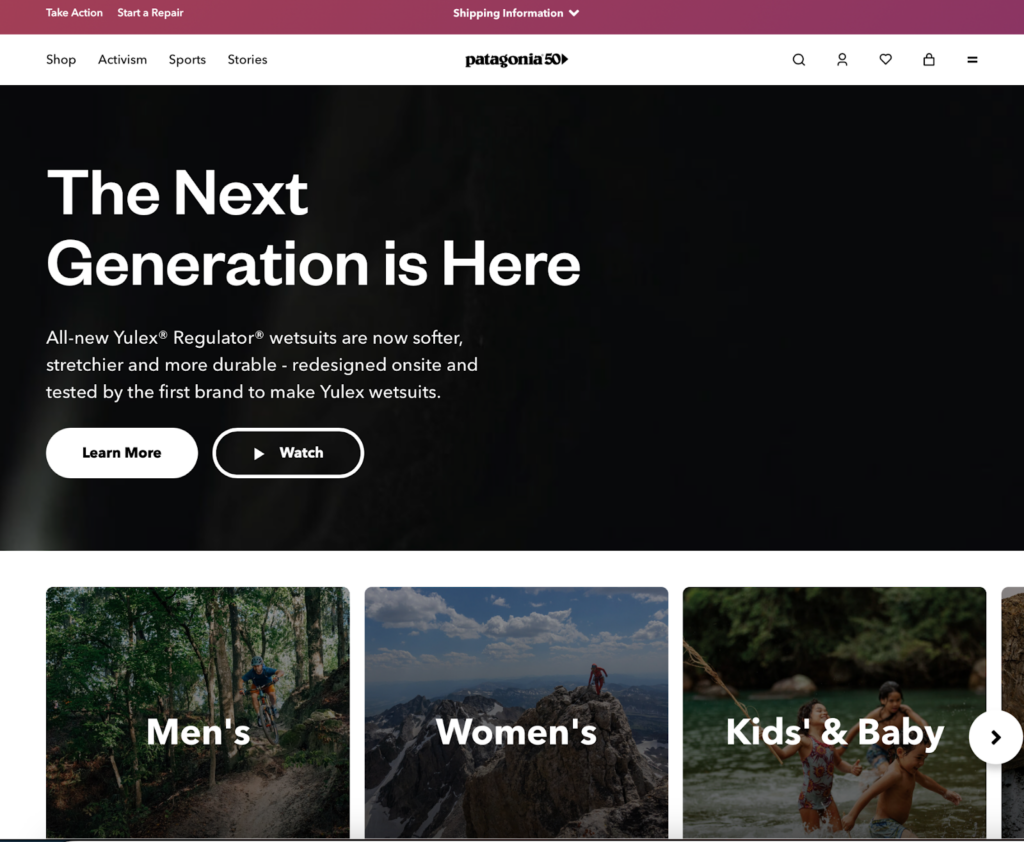
“Together, we can prioritize purpose over profit and protect this wondrous planet, our only home.”
Patagonia
🌎
How do they ensure their sustainability?
Patagonia puts sustainability at the center of their operation. They work to reduce, rather than simply offset, carbon emissions where it matters the most: in the supply chain and material manufacturing. They reduce their carbon footprint by removing high-impact virgin fossil-based fibers from their collections, using “Environmental Profit and Loss” to guide their production decision, and helping their suppliers to cut emissions. Patagonia’s fall 2023 collection is made up mostly of preferred materials (91% by fabric weight), including recycled cotton, regenerative organic cotton, hemp, and Man-Made Cellulose Fibers, which include modal, lyocell, and REFIBRA, all made by Lenzing. On top of that, Patagonia’s Worn Wear program encourages customers to repair and recycle their products, extending the textile lifecycle and reducing waste. Lastly, Patagonia is certified as a B Corporation and a Bluesign® brand.
🌐
How do they ensure their ethics?
Patagonia commits to fair trade practices. Through the partnership with Fair Trade USA, they currently produce 86% of their clothes in 20 Fair Trade Certified factories. Patagonia pays a premium for every item produced in such factories, accumulating in a fund for workers to use in their chosen community projects, whether in healthcare or parent support or to withdraw as a cash bonus. Additionally, they have various social responsibility programs to prevent harm and create positive impacts on the lives of apparel workers in their supply chain. These include the Fair Labor Association, the Living Wage Program, the Migrant Workers Program, and the Responsible Purchasing Practices. Patagonia is also fully transparent about the locations of their facilities and suppliers. Regarding animal rights, Patagonia has developed the Patagonia Wool Standard, which uses the Responsible Wool Standard as a foundation but goes beyond it in several key areas of animal welfare practices.
🤝
Are they part of any giving-back programs?
Since 1985, Patagonia has pledged 1% of sales annually to environmental causes. They have awarded over $89 million in cash and in-kind donations to domestic and international grassroots environmental groups, making a difference in their local communities. In 2022, the founder of Patagonia gave away his family’s ownership of the company to the newly created Patagonia Purpose Trust and the not-for-profit organization Holdfast Collective, ensuring that all future profits from the company are used to fight the climate and extinction crisis.
🛍️
What is their product range?
- Best for: kidswear, menswear, womenswear
- Product range: shirts, pants, jackets, blazers, hoodies, sweatshirts, T-shirts, shorts, plus-size
- Price range: $$$
- Size range: XXS–XXXL
ARMEDANGELS: Sustainable Clothing Brand Plus an Agent of Lifestyle Change

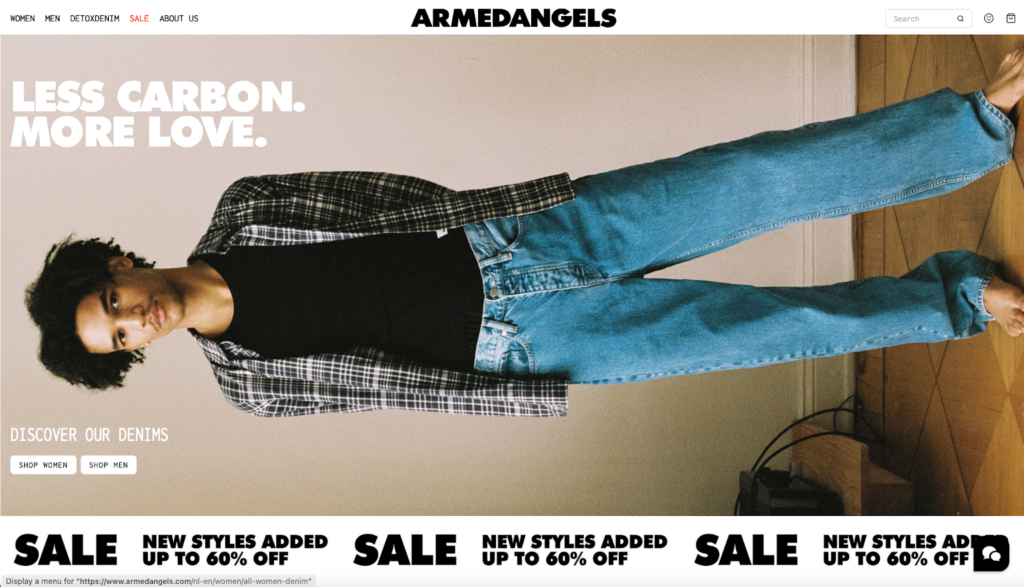
“So starting out with the humble tee, we took our oath against wage slavery, chemical shortcuts, and mass-producing pure crap, and transformed ourselves into one of the first clothing brands in all the land to put people and planet first.”
ARMEDANGELS
🌎
How do they ensure their sustainability?
ARMEDANGELS ensures sustainability by reducing carbon footprints while enabling people to change lifestyles to fight climate change. The brand innovates to cut down carbon emissions in their supply chain, starting with sourcing a high proportion of eco-friendly materials. Specifically, they use GOTS-certified organic cotton fabrics, GRS-certified recycled fabrics, GOTS-and RWS-certified organic wool fabrics, and FSC/PEFC-certified wood-based fabrics like TENCELTM Modal. Additionally, ARMEDANGELS chooses materials with the lowest carbon footprint possible, for example, opting for modal and lyocell over silk or natural fabrics over fossil-based synthetic fabrics while increasing recycled content, such as recycled wool and recycled cotton. For example, within a year, the share of recycled cotton in their DetoxDenim jeans increased from 5% to 37%, with some jeans in the collection containing 100% recycled cotton. Lastly, ARMEDANGELS’s efforts to encourage lifestyle change include care and repair guides to keep garments longer in circulation. They also have a resale platform that facilitates traded-in to be sold again as second-hand clothes or recycled as fibers for new clothes.
🌐
How do they ensure their ethics?
ARMEDANGELS ensures their ethics by only working with trusted partners to deliver decent wages and workers’ safety. They directly and actively monitor all their suppliers and the suppliers’ nominated subcontractors via on-site and online Internal Due Diligence Check and Self-Assessment, external audits by Fair Wear Foundation (FWF), Global Organic Textile Standard and third-party audits, continuous support, and tailored training programs by third parties. ARMEDANGELS ensures payment of a living wage in part of their supply chain and pays a markup where they notice wage issues via the living wage project. Most importantly, they are fully transparent about the journey from raw material to their products, especially where people and animals are involved, and the impacts of their actions.
🤝
Are they part of any giving-back programs?
ARMEDANGELS raises funds by donating part of their sales to support various organizations and campaigns. For example, during the COVID-19 pandemic, they have raised €745.800 ($790,883.61 USD) for Doctors Without Borders, facilitating isolation wards, COVID-19 clinics, and protective clothing for medical professionals worldwide. Other fundraising projects include supporting the climate movement with German Zero and the Climate Emergency Fund, fighting for equality with UN Women, advocating for fair payment and safe working conditions for Bangladeshi garment workers with the National Garment Workers Federation, and rescuing refugees in the Mediterranean Sea with Sea-Watch.
🛍️
What is their product range?
- Best for: kidswear, menswear
- Product range: denim jeans, jackets, jumpsuits, shorts, skirts, T-shirts
- Price range: $$
- Size range: XS–XXL
Tentree: A Lifestyle Clothing Brand That Plants Trees for Every Item Purchased

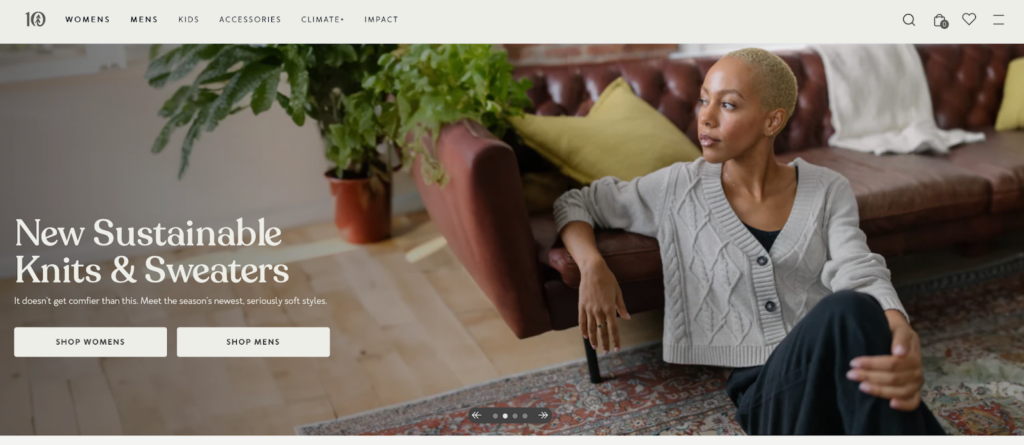
“ We believe the future of business is restorative.”
Tentree
🌎
How do they ensure their sustainability?
Tentree ensures sustainability by planting trees, promoting circularity, opting for low-impact fabrics, and attaining responsible packaging. Since their inception, they have planted more than 100,000,000 trees, which helps regenerate ecosystems, capture carbon, and provide forestry jobs in communities around the world. Together with textile recycler SuperCircle and resale guru Treet, Tentree has created an integrated solution to resell or recycle pre-loved Tentree clothing items, keeping them in circulation and out of landfills. Tentree also uses eco-friendly fabrics and blends based on organic cotton, hemp, recycled polyester, and TENCEL™ Lyocell and Modal fibers. Regarding packaging, they replaced all single-use plastics with FSC-certified and 100% recycled paper. Finally, they have B Corporation and Climate Neutral certifications.
🌐
How do they ensure their ethics?
Tentree enforces fair labor practices by collaborating only with manufacturers and suppliers that guarantee a safe and respectful environment for their employees. They regularly audit their partner facilities to ensure compliance with their Code of Conduct and international labor standards. Part of their supply chains is certified by organizations that protect workers, such as Fair Wear Foundation, Global Organic Textile Standard, Sedex Members Ethical Trade Audit, and Worldwide Responsible Accredited Production – WRAP. Additionally, Tentree commits to protecting forests through their paper, packaging, and fabric choices.
🤝
Are they part of any giving-back programs?
Giving back is a cornerstone of Tentree’s mission. Tentree plants 10 trees worldwide for every item purchased, contributing to reforestation and combating climate change. In 2022 alone, their customers helped plant over 22 million trees across nine countries, restoring over 2,000 hectares of terrestrial forests, over 1,000 hectares of coastal mangrove forests, and hundreds of hectares of marine land.
🛍️
What is their product range?
- Best for: kidswear, menswear, womenswear
- Product range: T-shirts, tank tops, shirts, sweaters, cardigans, dresses, pants, hoodies, dresses, shorts, skirts, joggers, jackets, coats, underwear
- Price range: $$
- Size range: XXS–XXL
Mara Hoffman: Womenswear Brand Promoting Mindful Fashion Habits
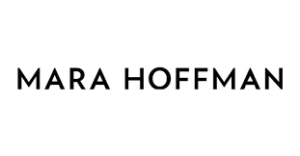

“As a team, we remain committed to reducing our footprint on the planet by extending the life of each garment, contributing to the regeneration of the environment, and advocating for the communities least responsible for, yet most impacted by, climate change.”
Mara Hoffman
🌎
How do they ensure their sustainability?
Mara Hoffman’s sustainability efforts focus on responsible materials, low-impact manufacturing practices, and mindful fashion habits. When sourcing for their designs, they prioritize natural, recycled, and organic materials over virgin synthetic fabrics while opting out of fur, leather, and feathers. Specifically, their modal fabrics are sourced from top-ranking man-made fiber producers on Canopy’s Hot Button Report, Lenzing and Birla Cellulose. Additionally, their packaging is free from plastics and uses natural materials that can be easily recycled. Since 2019, they have transitioned into 100% recycled paper mailers for small shipments. Regarding the manufacturing stage, Mara Hoffman aims to minimize waste and energy usage wherever possible. For example, they choose digital printing to reduce fabric waste and water waste. Lastly, they encourage mindful fashion habits such as “Wear More, Wash Less“, repairing, and repurposing to keep garments lasting a long time while reducing the climate impact. They also have a platform, Full Circle Marketplace, where you can buy and sell pre-owned Mara Hoffman garments.
🌐
How do they ensure their ethics?
Mara Hoffman works with Fair Trade Certified™ products and factories to ensure workers receive premium work payment. Additionally, they regularly conduct in-person factory visits. They also support the growth of smaller factories with incentives like sponsoring website development and delivering training programs on transparent record-keeping. For transparency, they publish the list of the Tier 1 factories where the last stage of production happens.
🤝
Are they part of any giving-back programs?
As Mara Hoffman has shifted toward sustainability, they have increased contributions to and participation in social justice movements. They give back in various ways, including sponsoring, fundraising, and mentoring, in partnership with many organizations working towards social justice and sustainability. The list includes Black in Fashion Council, CanopyStyle, Equality Now, Woman March, and Sweet Freedom Farm.
🛍️
What is their product range?
- Best for: womenswear
- Product range: dresses, tops, blouses, pants, skirts, swimwear, jumpsuits, playsuits, bodysuits, plus size
- Price range: $$$
- Size range: XS–XXXL
Encircled: Minimalist Clothing Essentials Made Without Compromising Style, Comfort, or the Planet

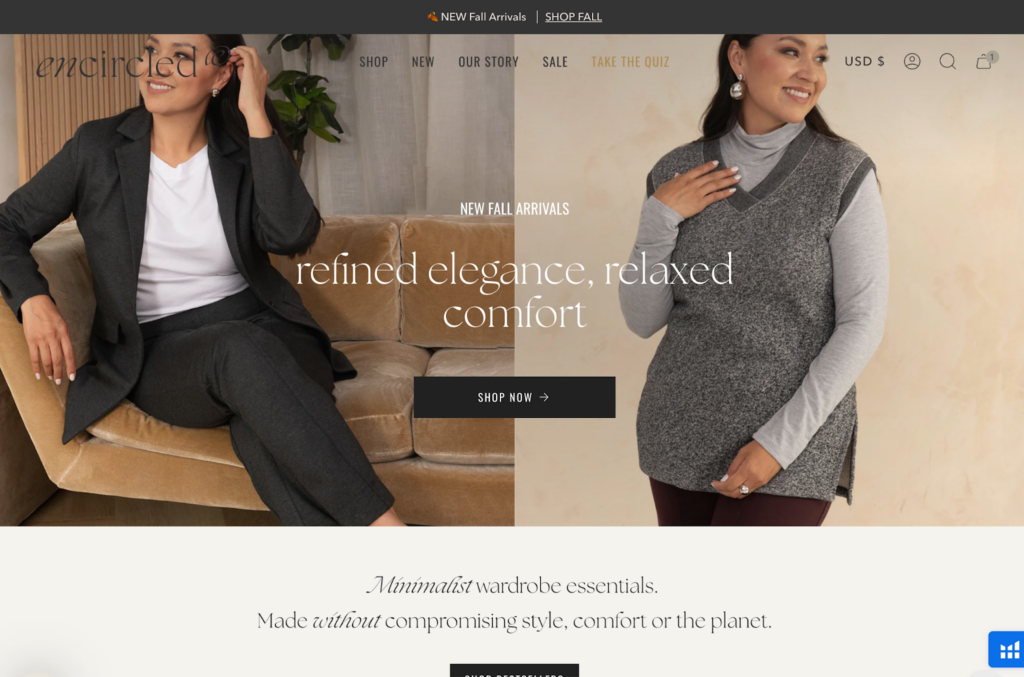
“Ethically made from the finest, most soft and flattering eco-friendly fabrics, our collection is designed with intention, flexibility and exceptional fit at its heart.”
Kristi Soomer, Founder of Encircled
🌎
How do they ensure their sustainability?
Encircled prioritizes sustainability through minimizing waste and maximizing options. They are vigilant about closing gaps in the supply chains and the life of each piece of clothing. Their sewing studios upcycle all scrap fabrics into accessories, putting them up for quarterly sales. Encircled Renewed Threads is a platform where you can find pre-loved items. It is also possible to buy, sell, or trade Encircled clothes on their Facebook community page. Other environmental incentives include using green energy to power their office and host their website, FSC-certified and eco-friendly paper and cleaning products, and 100% recyclable packaging. Encircled manufactures their products locally and spends at least 50% of their non-labor expenses at local independent suppliers to reduce their carbon footprint. Lastly, they prioritize natural fabrics, such as organic cotton and linen, and low-impact, plant-based semi-natural fabrics, such as TENCEL™ Lyocell, TENCEL™ Modal, and rayon from bamboo.
🌐
How do they ensure their ethics?
Encircled puts ethics at the core of their operations. Their final stage of production is undertaken in Canada, a low-risk country for labor abuse. They uphold each factory in their supply chain to an Ethical Code of Conduct checklist, exceeding what the law requires. Encircled also visits their international suppliers regularly. Lastly, they advocate continuously for diversity and inclusion.
🤝
Are they part of any giving-back programs?
Encircled is not known to be part of any giving-back programs.
🛍️
What is their product range?
- Best for: womenswear
- Product range: skirts, dresses, pants, jackets, blazers, knitwear, tops, blouses, T-shirts, stockings, tights, jumpsuits, playsuits, accessories, plus-size
- Price range: $$$
- Size range: XS–XXL
Whimsy + Row: Reducing Eco-Footprint With Every Step of the Process
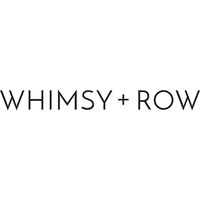
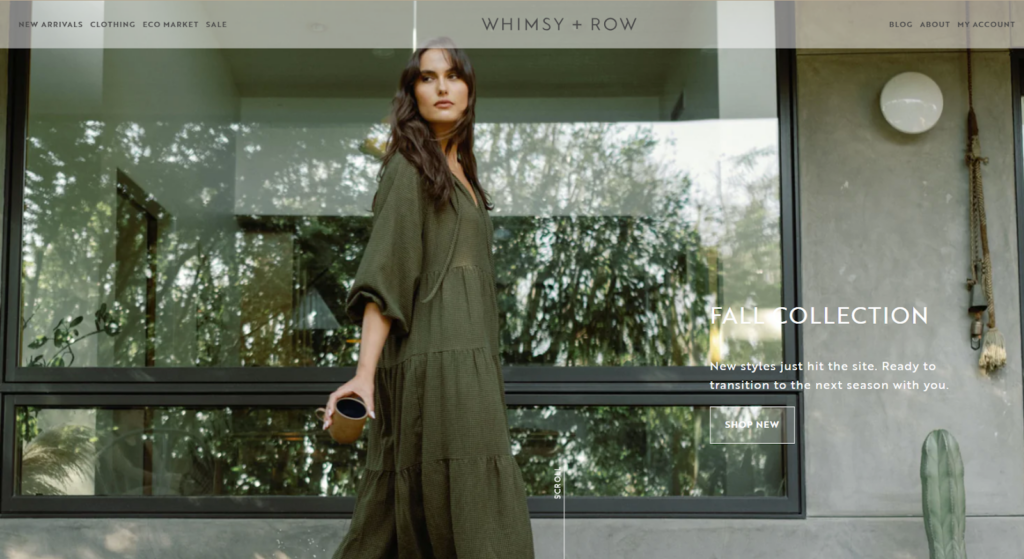
“Growing and being a good company.”
Rachel Temko, founder of Whimsy + Row
🌎
How do they ensure their sustainability?
Whimsy + Row prioritizes sustainability by opting for low-impact materials like modal and lyocell
trademarked by Lenzing, certified organic cotton, linen, and deadstock/upcycled fabrics. Their clothes are made with low-impact dyes and recycled water. Furthermore, they reduce waste through their small-batch production of long-lasting products and efforts to close the loop to reach zero waste. The final stages of manufacturing are done locally to reduce the transportation footprint. They further offset their carbon emission with the Carbon Fund. Whimsy + Row is carbon neutral.
🌐
How do they ensure their ethics?
Whimsy + Row clothing is made within a few miles of their office, enabling weekly factory visits. The brand ensures that fair wages are given and that workers are being treated fairly.
🤝
Are they part of any giving-back programs?
Whimsy + Row actively participates in giving-back programs that support environmental causes and community initiatives. Specifically, they donate money to organizations like One Tree Planted, People Tree, Global Fund for Women, Black Lives Matter, Reclaim the Block, Black Vision Collective, Downtown Women’s Health Center, and Feeding America. Once a month, their employees also donate their time to community work, such as cleaning the beach or planting trees.
🛍️
What is their product range?
- Best for: womenswear with eco-friendly, contemporary designs
- Product range: skirts, denim, dresses, pants, tops, blouses, shorts, lingerie, plus-size
- Price range: $$$
- Size range: XS–3XL
Toad&Co: Made-to-Order Clothes Using Highly Sustainable Materials
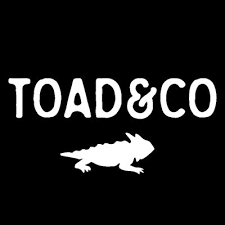
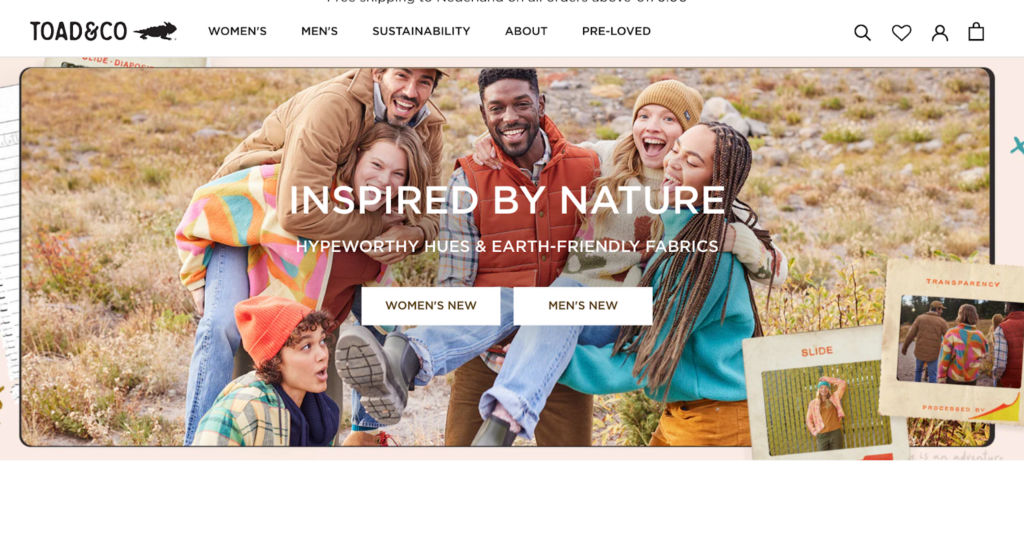
“Our commitment to a cleaner way of living and doing business has made us stronger and, like any good relationship, we take every day as it comes.”
Toad&Co
🌎
How do they ensure their sustainability?
Toad&Co promotes sustainability by sourcing eco-friendly materials, reducing carbon footprints, supporting textile circularity, and joining the responsible packaging movement. 100% of Toad&Co clothing is made with a minimum of 80% sustainable fibers and/or fabrics that have met Earth-friendly standards in accordance with Bluesign or Standard 100 by OEKO-TEX®. They use organic cotton, recycled fabrics, hemp, lyocell, and modal. Furthermore, they purchase Renewable Energy Certificates (RECs) for all Toad&Co locations to offset their energy use by supporting the development of emission-free renewable energy and carbon reduction projects. The ToadAgain platform enables reselling and buying pre-loved items to reduce waste and extend the lifespan of clothing items. Additionally, Toad&Co provides resources for consumers to mend and extend the usage of their clothes.
🌐
How do they ensure their ethics?
Toad&Co is committed to promoting fair labor practices and safe working conditions in all factories in their supply chain. Their manufacturers are held to Toad&Co’s Workplace Code of Conduct to provide employees with a sustainable work environment. Their Code of Conduct covers four of the ILO’s Fundamental Freedoms principles. They also visit vendors’ facilities on a yearly basis to ensure that their clothes are produced with integrity. In 2010, Toad&Co was named one of Outside Magazine’s best places to work.
🤝
Are they part of any giving-back programs?
At the very beginning of their journey, Toad&Co co-founded Planet Access Company, which employs adults with disabilities, fostering inclusivity and diversity in the workforce. Additionally, they run programs that support people with disabilities to make arts and enjoy outdoor adventures. They also give 1% of all sales to environmental causes via 1% for the Planet membership. In the last 20 years, they have helped to fund 120 environmental protection organizations.
🛍️
What is their product range?
- Best for: menswear, womenswear
- Product range: shirts, sweaters, dresses, pants, maternity wear, T-shirts, shorts, underwear
- Price range: $$
- Size range: XS–XL
TAMGA Designs: Luxurious, Lightweight, and Forest-Friendly Clothing
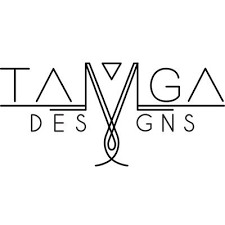
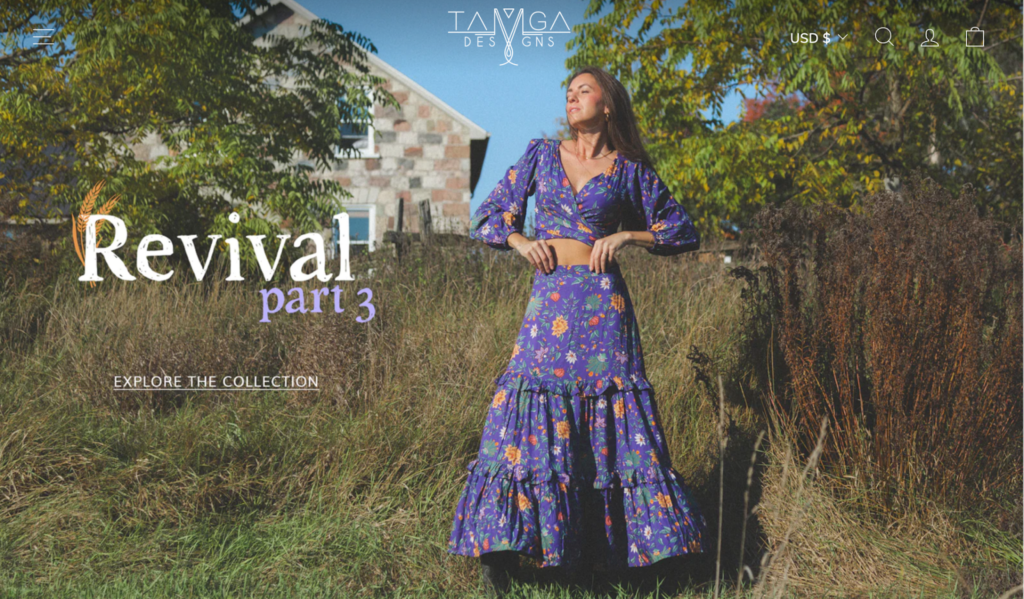
“We believe in a bright future for our planet, which is why we only use fabrics made from traceable and sustainable botanic fibers. ”
TAMGA Designs
🌎
How do they ensure their sustainability?
TAMGA Designs ensures sustainability by lowering their environmental impacts throughout the life-cycles of their clothes. In the material sourcing stage, they use only 100% biodegradable and recyclable fabrics, including low-impact, certified, traceable wood-based fabrics (lyocell, modal, viscose) from Lenzing and European-original linen. To manufacture their colorful collection, TAMGA Designs opts for OEKO-TEX® 100 certified dyes that use 70% less water than conventional synthetic dyes. Each finished product is packed in an unbleached GOTS-certified organic cotton tote bag that can be reused for traveling or home storage. Other packing elements are made with recycled, recyclable, or compostable materials. TAMGA Designs also uses the leftover fabric from previous collections to create the “Revival” collection. Lastly, they offset all carbon emissions to make their garments carbon-neutral. In 2022, through their partnership with SimpliZero, TAMGA Designs invested in Gold-Standard offsetting projects, including the Sirap Wind Farm in Indonesia, a Bundled Wind Power project in China, and a Clean Drinking Water project in Cambodia.
🌐
How do they ensure their ethics?
TAMGA Designs ensures their ethics by sharing every supplier that touches a TAMGA garment, from “field to fashion.” Their direct suppliers are upheld to a Code of Conduct that covers all of ILO’s Fundamental Freedoms principles. They visit most of their suppliers regularly.
🤝
Are they part of any giving-back programs?
Since their inception, TAMGA Designs has always given back a portion of their sales to causes they care about. Through their partnership with 1% For the Planet, they give 1% of the annual sales to the Sumatran Orangutan Society (S.O.S.). The fund is used to replant the rainforests in Sumatra, restoring one of the world’s most important biodiversity hotspots and bringing back the habitat for four critically endangered species, including orangutans, rhinos, elephants, and tigers. Additionally, they have a special T-shirt collection made with Lenzing’s modal fabrics, Trees Please Tee, for which they contribute $10 per every sold item to S.O.S. In 2022, they celebrated Forest-Friendly-Friday and International Orangutan Day, donating 20% and 25% of all sales, respectively, to the Sumatran Orangutan Society.
🛍️
What is their product range?
- Best for: womenswear, kidswear
- Product range: skirts, shirts, dresses, pants, tops, blouses, shorts, jumpsuits, playsuits, T-shirts, kimonos, loungewear, accessories, plus size
- Price range: $$$$
- Size range: XS–XXL
Ecoalf: Committing to Recycling Waste and Cleaning the Environment

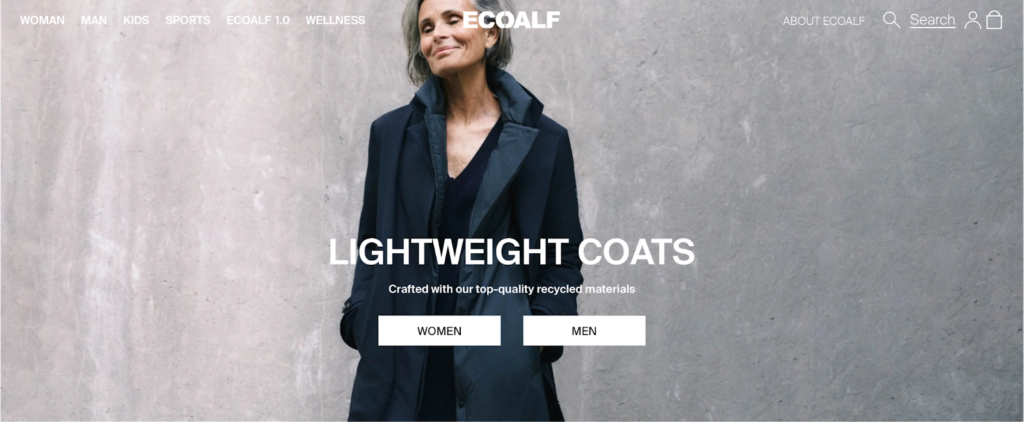
“I believe the time when fashion was just about looking good is over. More than ever it has to be about doing what is right and feeling good about it.”
Javier Goyeneche, founder of Ecoalf
🌎
How do they ensure their sustainability?
Ecoalf’s commitment to sustainability is evident in their innovative recycling practices. They minimize the use of natural resources by using mainly waste as raw materials, collecting and transforming discarded materials such as plastic bottles, discarded fishing nets, and post-industrial cotton into high-quality fashion items. In 2023, they launched their first 100% recycled cotton collection that can be recycled again to achieve circularity. In 2021, 74% of the materials used by Ecoalf were recovered from waste, saving 1,377 tons of CO₂. In combination with recycled fabrics, including mechanically recycled cotton, recycled wool, recycled polyester, and recycled nylon, Ecoalf also sources some low-impact materials, such as natural fabrics (linen, hemp, kapok) and semi-natural fabrics, including modal. Ecoalf is also Bluesign® and B Corporation certified.
🌐
How do they ensure their ethics?
Ecoalf ensures their ethics by protecting their workers and the environment. In particular, they ensure there are safe and fair working conditions in their supply chain by mandating a Code of Conduct, an Equality Scheme, a Crime Prevention Handbook, a Disciplinary System, and a Bullying at Work Protocol. Additionally, they run many campaigns to raise awareness of the state of our ocean and earth-damaging consumerism habits.
🤝
Are they part of any giving-back programs?
Ecoalf actively participates in giving-back programs. The Ecoalf Foundation was founded to clean the oceans of marine waste with the help of the fishing industry while giving a second life to plastic waste through recycling and closing the loop. They achieve that with their “Upcycling the Oceans” projects. In 2021, Ecoalf donated 10% of all Because There’s No Planet B sales to the Ecoalf Foundation to expand the “Upcycling the Oceans” project beyond the Spanish border and into countries like Thailand, Greece, and France. The foundation also partners with Biotherm to set up the framework of “Limpia ríos, salva océanos”, a project supported by corporate volunteer days to collect waste and restore the environment. Additionally, Ecoalf’s employees volunteer in various environmental incentives.
🛍️
What is their product range?
- Best for: womenswear, menswear, kidswear
- Product range: shirts, pants, jackets, blazers, hoodies, sweatshirts, tops, blouses, knitwear, T-shirts, sneakers, accessories
- Price range: $$
- Size range: XS–XL
CASAGiN: Clothing Items Made With Natural and Circular Fabrics
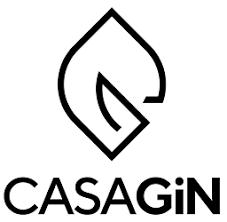
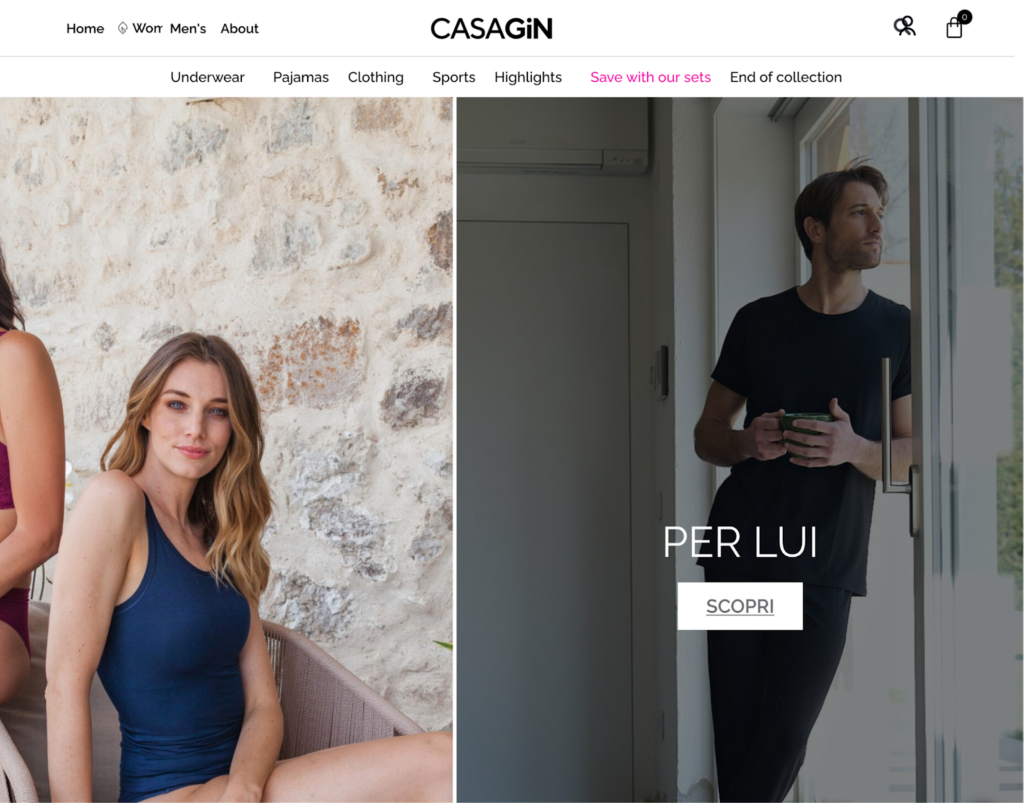
“We are proud to be one of the first Italian underwear and clothing brands to incorporate sustainability into every area of the business.”
CASAGiN
🌎
How do they ensure their sustainability?
CASAGiN prioritizes sustainability by opting for a high proportion of eco-friendly materials, lowering their carbon footprint, and reducing waste by reusing some of their offcuts. They source natural fibers such as beechwood (TENCELTM Modal), eucalyptus wood (TENCELTM Lyocell), and cotton fibers cultivated organically for their underwear and clothing. Alternatively, they use circular fabrics, including biodegradable nylon, recycled polyester, and Econyl (recycled nylon). Further down the life-cycle in the manufacturing stage, CASAGiN lowers their carbon footprint by making their products locally at a maximum distance of 70 km from their headquarters to reduce transportation emissions, using 100% renewable energy in factories, and having a system installed to save and reuse the energy used in the various processes. Regarding packaging, CASAGiN uses completely biodegradable corn-based bags with TUV Austria certification and recycled cardboard boxes. They also opt for a courier that offsets the carbon emissions of transportation. Lastly, their products have various sustainability certifications, including the Global Organic Textile Standard (GOTS), Global Recycle Standard (GRS), Forest Stewardship Council (FSC), OEKO-TEX® Standard 100, EU Ecolabel, REACH, and Bluesign.
🌐
How do they ensure their ethics?
CASAGiN ensures their ethics by being fully transparent about the factories that make their clothing items. These manufacturing factories are located in Europe, where strict rules against labor abuse and unfair working conditions are applied.
🤝
Are they part of any giving-back programs?
CASAGiN is not known to be part of any giving-back programs.
🛍️
What is their product range?
- Best for: menswear, womenswear
- Product range: swimwear, slips, period underwear, bras, tank tops, activewear, T-shirts, pajamas
- Price range: $$
- Size range: S–XL
Threads 4 Thought: Everyday Basics Produced Responsibly

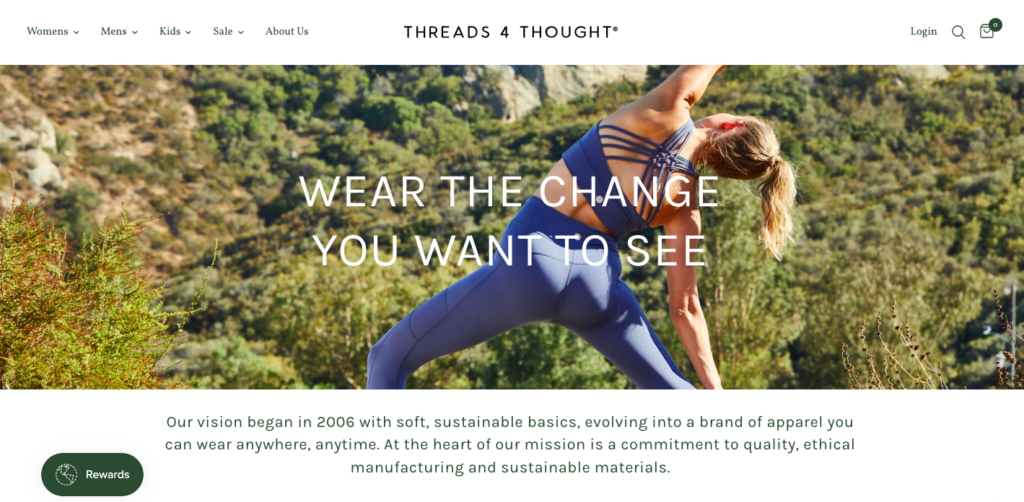
“From our original designs to our fabrics to the factory floor, we are committed to leaving an innately smaller impact on our planet.”
Threads 4 Thought
🌎
How do they ensure their sustainability?
Threads 4 Thought promotes sustainability by sourcing a high proportion of eco-friendly materials including recycled polyester, organic cotton, and modal with Lenzing’s renewable beech tree pulp. Further down the life-cycle in manufacturing, they lower their environmental impacts by implementing a dye technology that eliminates all harmful chemicals and reduces water usage during the dyeing process by 95%. They also recycle 80% of their main factory’s industrial wastewater. Additionally, their packing materials are fully FSC-certified, with 90% being WaveBags, which are 100% recyclable, water resistant, and strong. Lastly, 99% of their products are transported by boat rather than air, reducing carbon emissions during the transportation stage.
🌐
How do they ensure their ethics?
Threads 4 Thought traces most of their supply chain and reduces their impact through Greenstory. They have a Supplier Code of Conduct that covers all ILO’s Fundamental Freedoms.
🤝
Are they part of any giving-back programs?
Threads 4 Thought partners with the International Rescue Committee to help people displaced due to conflicts.
🛍️
What is their product range?
- Best for: menswear, womenswear, kidswear
- Product range: sweaters, dresses, pants, jackets, blazers, shorts, hoodies, sweatshirts, T-shirts, tops, blouses, maternity, stockings, tights, jumpsuits, playsuits, sportswear, sleepwear, accessories, plus size
- Price range: $$
- Size range: XS–XXL
Amour Vert: Stylish and Environmentally Friendly Clothing Made in the US

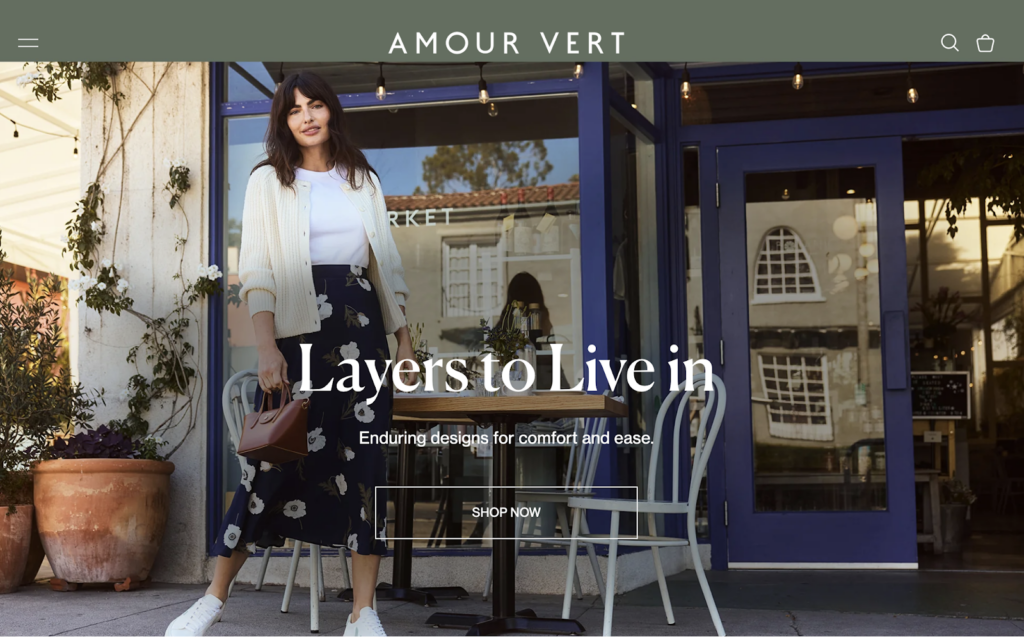
“Our sustainable practices address all aspects of our business operations and the full lifecycle of the garment: the fibers and production processes used, how workers are treated, how it gets to the consumer, and finally—whether it can be recycled or is forced into a landfill.”
Amount Vert
🌎
How do they ensure their sustainability?
Amour Vert ensures sustainability by using traceable, eco-friendly materials and promoting circular fashion. They use a medium proportion of lower-impact fibers, including organic cotton, linen, TENCEL™ Lyocell and TENCEL™ Modal. Additionally, they opt for recycled varieties of higher-impact fabrics, such as polyester and cashmere, to reduce their carbon footprint. The silk used in Amount Vert’s collection is Bluesign® certified. Regarding circular fashion initiatives, Amour Vert uses deadstock fabric and sells pre-loved clothing through their resale marketplace, ReAmour.
🌐
How do they ensure their ethics?
Amour Vert traces part of their supply chain, including suppliers in the final stage of production, which happens in the US.
🤝
Are they part of any giving-back programs?
Amour Vert partners with American Forests® to plant trees in North America: with every purchase of a tee, they plant a tree.
🛍️
What is their product range?
- Best for: womenswear
- Product range: shirts, denim, sweaters, dresses, pants, tops, blouses, T-shirts
- Price range: $$
- Size range: XS–XXL
OhSevenDays: Ethical Clothing Made With Surplus or Deadstock Fabrics

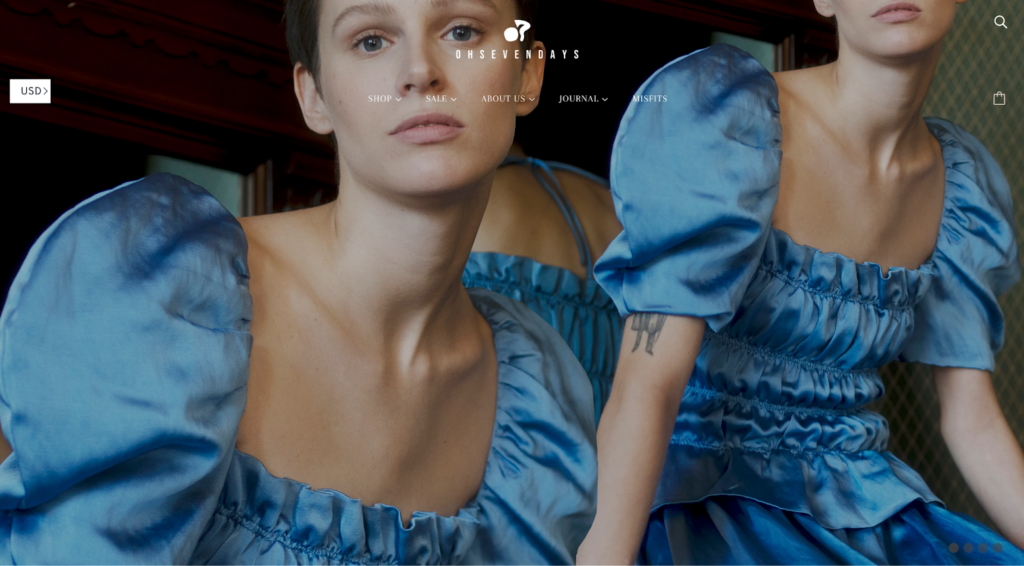
“ We produce our garments with sustainability in mind and therefore source materials from deadstock fabric rolls. Being based in Istanbul, one of the textile manufacturing capitals of the world, we are lucky to have access to these factories and their beloved forgotten leftovers! ”
OhSevenDays
🌎
How do they ensure their sustainability?
OhSevenDays ensures sustainability by sourcing deadstock fabrics for their collections while promoting the idea of slow fashion. They use low-impact materials, especially natural fabrics (linen, organic cotton) and plant-based semi-natural fabrics, including modal and cupro sourced from the surplus deadstock at OEKO-TEX®-certified fabric mills. By using deadstocks with sustainability certifications like Global Organic Textile Standard (GOTS), Global Recycled Standard (GRS), Organic Content Standard (OCS), and European Flax, they reduce the environmental impacts of their products while reducing textile waste. Additionally, OhSevenDays minimizes waste by limiting their production runs and offering a zero-waste misfit collection made with fabrics with small faults that they rescued.
🌐
How do they ensure their ethics?
OhSevenDays traces most of their supply chain. Their manufacturing partner is a member of the ethical trade membership organization Sedex based in Istanbul. The factory is fully audited, fair trading, and worker-friendly. Additionally, OhSevenDays binds all their suppliers in a Code of Conduct that covers four of ILO’s Fundamental Freedoms.
🤝
Are they part of any giving-back programs?
OhSevenDays is not known to be part of any giving-back programs.
🛍️
What is their product range?
- Best for: womenswear
- Product range: shirts, sweaters, dresses, hoodies, sweatshirts, tops, blouses, jumpsuits, playsuits, accessories
- Price range: $$$
- Size range: XS–XL
Modal Fabrics: Breathable and Biodegradable Plant Material
Modal fabrics are semi-natural/semi-synthetic fabrics made with plant materials. TENCEL™ Modal and Birla Modal are two examples of modal fabrics made in closed-loop processes where chemicals are recovered and reused.
Here are the life-cycle stages of modal fabrics and each stage’s sustainability assessment:
- Sourcing of modal fabrics: The sourcing stage is generally sustainable because modal fabrics are made from renewable beechwood, obtainable from managed forests across North America and Europe.
- Manufacturing of modal fabrics: Manufacturing modal fabric is energy and chemical intensive, which could have serious knock-on ecological impacts, especially if fossil fuels are the main energy sources at the manufacturing locations. However, integrated manufacturing processes can recover part of the energy during production while optimizing materials. In this case, manufacturing modal fabrics can be designed to be more sustainable.
- Transportation of modal fabrics: Transporting can be a carbon-intensive stage in the life-cycle of clothing items made with modal fabrics due to the distances covered and emissions associated with transporting vehicles. Modal fabrics typically travel from forests, where raw materials for modal are grown, to processing and finishing factories, sorting centers, shops, and consumers’ homes before going to recycling centers or landfills.
- Usage of modal fabrics: The usage of modal fabrics is sustainable because modal clothing tends to last a long time while requiring few washes.
- End-of-life of modal fabrics: The end-of-life stage for modal fabric is generally sustainable because it is reusable, biodegradable, and compostable.
Modal is generally a sustainable material. It is made with natural cellulose fibers and is fully biodegradable at the end of its life-cycle. Its modified manufacturing process is less energy and chemical-intensive than the first generation of rayon (viscose), making it a more sustainable option.
Why Is It Important to Buy Products Made of More Sustainable Fabrics
It is important to buy products made of more sustainable fabrics because a sustainable textile industry has a lower carbon footprint, helps save natural resources, and is better for forests, animals, and humans.
Buying Sustainable Fabrics Reduces Your Carbon Footprint
The production of clothing and footwear is estimated to contribute 10% of global greenhouse gas emissions—more than all international flights and shipping combined. If the fashion industry were a country, it would be the fourth largest emitter of carbon dioxide.
One way to reduce the carbon footprint of the clothes you buy is to opt for sustainable fabrics. Sustainable fabrics, which are often made with natural or recycled fibers, have relatively low carbon footprints compared to petroleum-based fabrics. For example, organic cotton made in the US has a carbon footprint of 2.35 kg CO2 (per ton of spun fiber)—a quarter of polyester’s carbon footprint.
Buying Sustainable Fabrics Reduces Demand For Natural Resources and Waste Management
The textile industry uses water and land to grow cotton and other fibers. It is estimated that 79 billion cubic meters of water were used for the sector worldwide in 2015. For example, producing a single cotton t-shirt requires as much water as one person drinks for 2.5 years (2,700 liters of fresh water).
Worse yet, the textile economy is vastly more linear than circular: the largest amount of resources used in clothes ended up in landfill (instead of being recycled to remake clothes). According to a report by the Ellen MacArthur Foundation,
- Less than 3% of materials used in the textile economy in 2015 came from recycled sources.
- In other words, more than 97% of resources used in making clothes are newly extracted.
When clothing items are disposed of within a short period of time—under a year in the case of half of the fast fashion clothes—the natural systems that provide raw materials for fabrics don’t have enough time to recover and regenerate, which could lead to ecological breakdown.
Sustainable fabrics are made with less water and emissions while lasting longer:
- Because they are durable, you don’t need to buy new clothes too often.
- Thus, you help reduce the pressure to extract more resources for making new items.
Similarly, making and consuming sustainable fabrics made with recycled materials reduces the demand for virgin materials while helping tackle waste management.
Buying Sustainable Fabrics Encourages Sustainable Management of Forests
Sustainable plant-based fabrics are made with raw materials from forests and plantations that are sustainably managed, such as complying with FSC standards.
When you buy sustainable plant-based fabrics, you discourage unsustainable forestry practices like illegal logging. You can help reduce deforestation, biodiversity loss, and the effects of climate change.
Buying Sustainable Fabrics Encourages Fairer Treatment of Animals
The fashion industry is rife with animal mistreatment when it comes to making animal-based fabrics like wool or silk. Every year, billions of animals suffer and die for clothing and accessories.
Buying sustainable vegan alternatives can help to reduce the pressure on raising more and more animals to meet the demand for animal-based fabrics while sacrificing their well-being and lives.
Suppose you have to buy fabrics made with, for example, wool or silk; make sure you only choose brands committed to cruelty-free products. In that case, you help advocate better treatments for animals raised within the textile industry.
Using Sustainable Fabrics Encourages Fairer Treatment of Textile Workers
Recent statistics from UNICEF estimated as many as 170 million child laborers worldwide, many of whom were engaged in some form of work in the textile industry. They don’t get paid minimum wages and often work long hours.
When you buy sustainable fabrics from brands transparent about the working conditions at their factories, you discourage the use of child labor and help promote better working conditions for textile workers.
How Can You Generally Buy More Sustainable Fabrics
The key to sustainably buying fabrics is to check on relevant environmental and original certifications.
For natural fabrics:
- Global Organic Textile Standard (GOTS): A globally recognized certification system that ensures a certain threshold of organic content has been met. It covers manufacturing, packaging, labeling, transportation, and distribution (but not what happens in the fields where crops are grown).
- USDA Certified Biobased Product: The USDA BioPreferred® Certification is a voluntary certification offered by the United States Department of Agriculture. The certification identifies products made from plants or other renewable materials.
- Ecolabel: Ecolabel is the official European Union voluntary label recognized worldwide for certified products with a guaranteed, independently verified low environmental impact. The label requires high environmental standards throughout the entire life-cycle: from raw material extraction through production and distribution to disposal. It also encourages companies to develop innovative, durable, easy-to-repair, and recyclable products.
For plant-based semi-natural/semi-synthetic fabrics:
- Forest Stewardship Council: An FSC certification ensures that the wood (or wood-like material) comes from responsibly managed forests that provide environmental, social, and economic benefits.
There are two types of FSC Certification:- FSC Forest Management Certification, with a focus on the origin of the wood—the forest.
- FSC Chain of Custody Certification, which focuses on the path from the forest to the customer’s home.
- Program for Endorsement of Forest Certification: PEFC’s approaches to sustainable forest management are in line with protecting the forests globally and locally and making the certificate work for everyone. Getting a PEFC certification is strict enough to ensure the sustainable management of a forest is socially just, ecologically sound, and economically viable but attainable not only by big but small forest owners.
For recycled fabrics:
- Recycled Claim Standard (RCS): The Textile Exchange RCS was originally developed as an international, voluntary standard that sets requirements for third-party certification of Recycled input and chain of custody.
- The Global Recycled Standard (GRS): The Global Recycled Standard (GRS) is an international, voluntary, full product standard that sets requirements for third-party certification of Recycled Content, chain of custody, social and environmental practices, and chemical restrictions. It can be used for any product with more than 20% recycled material.
For all types of fabrics:
- STeP by OEKO-TEX®: STeP by OEKO-TEX® is an independent certification system for brands, retailers, and manufacturers from the textile and leather industry. It communicates organizational environmental measures, including reducing carbon footprint and water usage.
- OEKO-TEX® Standard 100: OEKO-TEX® labels aim to ensure that products pose no risk to human health (i.e., containing banned chemicals).
Some certifications that are signaling brands’ efforts toward lowered environmental impacts and a circular economy are:
- B Corp Certification: The label B Corp is a certification reserved for for-profit companies. Certified holders are assessed on their social and environmental impacts.
- Cradle2Cradle certification: Cradle2Cradle provides a standardized approach to material circularity. It assesses whether products have been suitably designed and made with the circular economy in mind covering five critical categories: material health, material reuse, renewable energy and carbon management, water stewardship, and social fairness.
Final Thoughts
Modal is a breathable, durable textile material made with plant-based fibers. It is generally considered a sustainable fabric, especially when it is made in closed-loop systems that recycle and reuse chemicals and water.
By purchasing new or pre-loved modal clothes from brands that commit to sustainability, you support their mission to create a fairer and less harmful textile industry for all lives on Earth.
Here is the list (again) of the most sustainable modal clothing brands:
- Patagonia
- ARMEDANGELS
- Tentree
- Mara Hoffman
- Encircled
- Whimsy + Row
- Toad&Co
- TAMGA Designs
- Ecoalf
- CASAGiN
- Threads 4 Thought
- Amour Vert
- OhSevenDays
To make your use of these fabrics even more sustainable, follow these steps:
- Buy second-hand, recycled, or upcycled clothes made with modal fabrics.
- While using modal clothes, maximize the number of wears between washes and keep them as long as possible.
- At the end-of-life of your modal clothes, upcycle the materials to extend their usage and arrange for them to be recycled or properly disposed of.
Stay impactful,

Sources
- Impactful Ninja: How Sustainable Are Modal Fabrics? A Life-Cycle Analysis
- Science Direct: Sustainable Fibres and Textiles
- Impactful Ninja: How Sustainable is Beechwood? Here Are The Facts
- Britannica: Beech | Tree
- Science Direct: Life-cycle assessment (LCA)
- Lenzing: What is Modal fiber?
- Birla Cellulose: Birla Modal
- Patagonia: Home
- ARMEDANGELS: Home
- Tentree: Home
- MARA Hoffman: Home
- Encircled: Home
- Whimsy + Row: Home
- Toad&Co: Home
- TAMGA Designs: Home
- Ecoalf: Home
- CASAGiN: Home
- Threads 4 Thought: Home
- Amour Vert: Home
- OhSevenDays: Home
- Patagonia: The Climate Crisis Is Our Business
- Patagonia: The Climate Crisis Is Our Business | No More Virgin Petroleum Fibers by 2025
- Patagonia: The Climate Crisis Is Our Business | Is Each Product Worth the Environmental Cost?
- Patagonia: The Climate Crisis Is Our Business | Help Suppliers Cut Emissions
- Patagonia: Environmental Responsibility
- Patagonia: Recycled Cotton
- Patagonia: Regenerative Organic Certified Fibers
- Patagonia: Hemp
- Patagonia: Man-Made Cellulose Fibers
- Impactful Ninja: How Sustainable Are Lyocell Fabrics? A Life-Cycle Analysis
- Lenzing: REFIBRATM
- Lenzing: Home
- Patagonia: WORN WEAR
- B Corporation: Patagonia
- Bluesign®: Home
- Fair Trade: Home
- FAIR TRADE CERTIFIED: Improving Lives, Protecting the Planet.
- Patagonia: Social Responsibility
- Patagonia: Fair Trade
- Patagonia: Fair Labor Association
- Patagonia: Living Wage Program
- Patagonia: Migrant Workers Program
- Patagonia: Responsible Purchasing Practices
- Patagonia: Where We Do Business
- Patagonia: Patagonia Wool Standard (PWS) For Animal Welfare, Land Management and Traceability
- Textile Exchange: Responsible Wool Standard
- Patagonia: 1% for the Planet
- Forbes: Yvon Chouinard And The Patagonia Purpose Trust— What Is It And Will It Work?
- Fast Company: Patagonia uses capitalism to save the planet with the Holdfast Collective
- The New York Times: Patagonia Founder Gives Away the Company to Fight Climate Change
- Good On You: Brand Directory | ARMEDANGELS
- ARMEDANGELS: THE JOURNEY FROM RAW MATERIAL TO PRODUCT | A T-Shirt Made from Organic Cotton
- Impactful Ninja: How Sustainable Are Organic Cotton Fabrics? A Life-Cycle Analysis
- Textile Exchange: Global Recycling Standard
- Impactful Ninja: How Sustainable Are Recycled Fabrics? A Life-Cycle Analysis
- Global Organic Textile Standard (GOTS): Home
- Impactful Ninja: How Sustainable Are Organic Wool Fabrics? A Life-Cycle Analysis
- Forest Stewardship Council: Home
- Programme for the Endorsement of Forest Certification: Home
- Impactful Ninja: How Sustainable Are Wood-Based Fabrics? A Life-Cycle Analysis
- ARMEDANGELS: THE JOURNEY FROM RAW MATERIAL TO PRODUCT | Recycling
- ARMEDANGELS: About Us
- Impactful Ninja: How Sustainable Are Silk Fabrics? A Life-Cycle Analysis
- Impactful Ninja: How Sustainable Are Natural Fabrics? A Life-Cycle Analysis
- Impactful Ninja: How Sustainable Are Synthetic Fabrics? A Life-Cycle Analysis
- Impactful Ninja: How Sustainable Are Recycled Wool Fabrics? A Life-Cycle Analysis
- Impactful Ninja: How Sustainable Are Recycled Cotton Fabrics? A Life-Cycle Analysis
- ARMEDANGELS: DETOX DENIM
- ARMEDANGELS: Care Guide
- ARMEDANGELS: Repair Guide
- ARMEDANGELS: RETURN YOUR OLD CLOTHES | RECYCLING WITH BENEFITS
- ARMEDANGELS: ACTION REPORT 2021
- Fair Wear Foundation: Home
- ARMEDANGELS: LIVING WAGE PROJECT
- ARMEDANGELS: Collaborations
- Doctors Without Borders: Home
- German Zero: Home
- Climate Emergency Fund: Home
- Sea-Watch: Home
- Tentree: Tree Planting FAQ
- Tentree: Circularity By tentree
- Tentree: Our Materials
- Tentree: Thinking Outside the Box
- Tentree: WE’RE TENTRE | We Believe Big Change Starts Small.
- SuperCircle: Home
- Treet: Home
- Tentree: SuperCircle
- Tentree: Our Materials | Organic Cotton
- Tentree: Our Materials | Hemp
- Impactful Ninja: How Sustainable Are Recycled Polyester Fabrics? A Life-Cycle Analysis
- Lenzing: Sustainability
- B Corporation: Tentree
- CLIMATE NEUTRAL: Tentree
- Tentree: Ethical Manufacturing
- Good On You: Brand Directory | Tentree
- Sedex Members Ethical Trade Audit: Home
- Worldwide Responsible Accredited Production – WRAP: Home
- Shopify: Ten Tree International Inc. (tentree) | Commitment to Protect Forests Through Our Paper, Packaging and Fabrics Choices
- Tentree: THE ENVIRONMENTOR | Here’s Where We Plant Your Trees
- Tentree: 04 nature | TENTREE SUSTAINABILITY
- Mara Hoffman: Our Materials
- Impactful Ninja: How Sustainable Are Synthetic Fabrics? A Life-Cycle Analysis
- Mara Hoffman: Our Manufacturing
- Mara Hoffman: Wear More, Wash Less
- Mara Hoffman: Full Circle Marketplace
- Fair Trade Certified™: Home
- Good On You: Brand Directory | Mara Hoffman
- Mara Hoffman: Our Story
- Mara Hoffman: Our Commitments
- Black in Fashion Council: Home
- CanopyStyle: Home
- Equality Now: Home
- Woman March: Home
- Sweet Freedom Farm: Home
- B Corporation: Encircled
- Encircled: Our Promise
- Encircled: Encircled Renewed Threads
- Good On You: Brand Directory | Encircled
- Encircled: Where It’s Made
- Impactful Ninja: How Sustainable Are Linen Fabrics? A Life-Cycle Analysis
- Impactful Ninja: How Sustainable Are Semi-Natural/ Semi-Synthetic Fabrics Fabrics? A Life-Cycle Analysis
- TENCEL: TENCELTM Lyocell
- TENCEL: TENCEL™ Modal
- Impactful Ninja: How Sustainable Are Rayon Fabrics? A Life-Cycle Analysis
- Impactful Ninja: How Sustainable Are Bamboo Fabrics? A Life-Cycle Analysis
- Encircled: Encircled Supplier Ethical Practices
- Our Forest: Can you shop at Encircles sustainably
- Whimsy + Row: ABOUT OUR FABRIC
- Impactful Ninja: How Sustainable Are TENCELTM Fabrics? A Life-Cycle Analysis
- Whimsy + Row: OUR VALUES & SUSTAINABILITY
- Good On You: Brand Directory | Whimsy + Row
- Whimsy + Row: OUR STORY
- Carbon Fund: Home
- One Tree Planted: Home
- Black Lives Matter: Home
- Feeding America: Home
- TOAD&CO: A TOAD IS BORN
- TOAD&CO: SUSTAINABILITY
- TOAD&CO: THE CIRCULAR ECONOMY
- TOAD&CO: OUR PACKAGING JOURNEY
- FIBRE2FASHION: Interview With Gordon Seabury
- OEKO-TEX: Standard 100 by OEKO-TEX®
- Impactful Ninja: How Sustainable Are Hemp Fabrics? A Life-Cycle Analysis
- THE INTERNATIONAL REC STANDARDS: HOME
- TOAD&CO: OUR HISTORY
- TOAD&CO: ToadAgain Platform
- TOAD&CO: WORKPLACE CODE OF CONDUCT
- International Labour Organization: Home
- International Labour Organization: ILO Declaration on Fundamental Principles and Rights at Work
- TOAD&CO: GOOD BUSINESS
- Planet Access Company: Home
- TOAD&CO: EVERYONE DESERVES OPPORTUNITIES
- SEARCH INC: SEARCH FOR ADVENTURE
- TOAD&CO: GOOD PRODUCTS ARE NOTHING WITHOUT GOOD INTENTIONS
- One Percent For The Planet: Home
- TAMGA Designs: Fabrics & Dyes
- Impactful Ninja: How Sustainable Are Viscose Fabrics? A Life-Cycle Analysis
- TAMGA Designs: 2022 Impact Report
- TAMGA Designs: Revival
- TAMGA Designs: Our Impact
- Good On You: Brand Directory | TAMGA Designs
- TAMGA Designs: Giving Back | Replanting the Rainforest
- Ecoalf: Materials
- Ecoalf: History
- Ecoalf: DON’T THINK IT’S A UTOPIA | DISCOVER OUR 2021 SUSTAINABILITY REPORT
- Impactful Ninja: How Sustainable Are Recycled Wool Fabrics? A Life-Cycle Analysis
- Impactful Ninja: How Sustainable Are Recycled Polyester Fabrics? A Life-Cycle Analysis
- Impactful Ninja: How Sustainable Are Recycled Nylon Fabrics? A Life-Cycle Analysis
- Impactful Ninja: How Sustainable Are Natural Fabrics? A Life-Cycle Analysis
- Impactful Ninja: How Sustainable Are Kapok Fabrics? A Life-Cycle Analysis
- B Corporation: Ecoalf
- Ecoalf: Sustainable Report 2021 | DON’T THINK IT’S A UTOPIA
- Ecoalf: ECOALF foundation
- Ecoalf: Upcycling the Oceans
- Ecoalf: Because There’s No Planet B
- Ecoalf: Personas
- Good On You: Brand Directory | CASAGiN
- CASAGiN: Materials
- CASAGiN: Materials | TENCEL™ Modal
- CASAGiN: Materials | TENCEL™ Lyocell
- CASAGiN: Materials | GOTS-Certified Cotton
- CASAGiN: Materials | Biodegradable Nylon
- CASAGiN: Materials | Recycled Polyester
- CASAGiN: Materials | Econyl
- CASAGiN: Made in Italy
- Textile Exchange: Global Recycle Standard
- Forest Stewardship Council: Home
- OEKO-TEX: OEKO-TEX® Standard 100
- EU Ecolabel: Home
- European Union: REACH Regulation
- Good On You: Brand Directory | Threads 4 Thought
- Threads 4 Thought: Materials
- Threads 4 Thought: Ethical Manufacturing
- WaveBags: Home
- Threads 4 Thought: About Threads 4 Thought
- Greenstory: Home
- International Rescue Committee: Home
- NEWSWIRE: Threads for Thought Donates $200,000 to the International Rescue Committee
- Good On You: Brand Directory | Amount Vert
- Impactful Ninja: How Sustainable Are Linen Fabrics? A Life-Cycle Analysis
- Impactful Ninja: How Sustainable Are Polyester Fabrics? A Life-Cycle Analysis
- Amount Vert: Our Signature Fabrics
- Amount Vert: ReAmour
- American Forests® : Home
- Amount Vert: Buy a tee, plant a tree
- OhSevenDays: Sustainable Sourcing
- OhSevenDays: About Us
- Impactful Ninja: How Sustainable Are Cupro Fabrics? A Life-Cycle Analysis
- Textile Exchange: Organic Content Standard
- Alliance for European Flax-Linen & Hemp: European FlaxTM Certification
- Good On You: Brand Directory | OhSevenDays
- OhSevenDays: The Zero Waste Misfits
- OhSevenDays: Code of Conduct
- Impactful Ninja: How Sustainable Are Bamboo Fabrics? A Life-Cycle Analysis
- Intechopen: Natural Fibers: The Sustainable Alternatives for Textile and Non-Textile Applications
- European Parliament: The impact of textile production and waste on the environment (Infographic)
- Science Direct: The challenge of “Depeche Mode” in the fashion industry – Does the industry have the capacity to become sustainable through circular economic principles, a scoping review
- Science Direct: Carbon Footprint of Textile and Clothing Products
- European Parliament: Environmental impact of the textile and clothing industry
- European Parliament: What if fashion were good for the planet?
- Ellen MacArthur Foundation: A New Textiles Economy: Redesigning fashion’s future
- McKinsey: Style that’s sustainable: A new fast-fashion formula
- Forest Stewardship Council: Home
- Our World in Data: Deforestation and Forest Loss
- Our World in Data: Renewable Energy
- Peta: Animals Used For Clothing
- The Guardian: Child labour in the fashion supply chain
- BioPreferred: WHAT IS THE BIOPREFERRED PROGRAM?
- European Commission: Environment | EU Ecolabel
- FSC Forest Management Certification
- FSC Chain of Custody Certification
- Textile Exchange: The RCS and GRS are designed to boost the use of recycled materials
- OEKO-TEX: Certification according to STeP by OEKO-TEX®
- B Corp Certification: Home
- C2CCertified: Home




